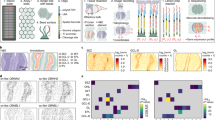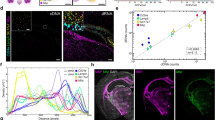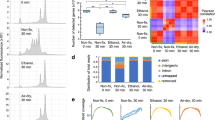Abstract
Spatial resolution of gene expression enables gene expression events to be pinpointed to a specific location in biological tissue. Spatially resolved gene expression in tissue sections is traditionally analyzed using immunohistochemistry (IHC) or in situ hybridization (ISH). These technologies are invaluable tools for pathologists and molecular biologists; however, their throughput is limited to the analysis of only a few genes at a time. Recent advances in RNA sequencing (RNA-seq) have made it possible to obtain unbiased high-throughput gene expression data in bulk. Spatial Transcriptomics combines the benefits of traditional spatially resolved technologies with the massive throughput of RNA-seq. Here, we present a protocol describing how to apply the Spatial Transcriptomics technology to mammalian tissue. This protocol combines histological staining and spatially resolved RNA-seq data from intact tissue sections. Once suitable tissue-specific conditions have been established, library construction and sequencing can be completed in ~5–6 d. Data processing takes a few hours, with the exact timing dependent on the sequencing depth. Our method requires no special instruments and can be performed in any laboratory with access to a cryostat, microscope and next-generation sequencing.
This is a preview of subscription content, access via your institution
Access options
Access Nature and 54 other Nature Portfolio journals
Get Nature+, our best-value online-access subscription
$29.99 / 30 days
cancel any time
Subscribe to this journal
Receive 12 print issues and online access
$259.00 per year
only $21.58 per issue
Buy this article
- Purchase on Springer Link
- Instant access to full article PDF
Prices may be subject to local taxes which are calculated during checkout







Similar content being viewed by others
References
Coons, A. H., Creech, H. J. & Jones, R. N. Immunological properties of an antibody containing a fluorescent group. Proc. Soc. Exp. Biol. Med. 47, 200–202 (1941).
Uhlén, M. et al. Tissue-based map of the human proteome. Science 347, 1260419 (2015).
Gall, J. G. & Pardue, M. L. Formation and detection of RNA-DNA hybrid molecules in cytological preparations. Proc. Natl. Acad. Sci. USA 63, 378–383 (1969).
Jin, L. & Lloyd, R. V. In situ hybridization: methods and applications. J. Clin. Lab. Anal. 11, 2–9 (1997).
Lubeck, E., Coskun, A. F., Zhiyentayev, T., Ahmad, M. & Cai, L. Single-cell in situ RNA profiling by sequential hybridization. Nat. Methods 11, 360–1 (2014).
Chen, K. H., Boettiger, A. N., Moffitt, J. R., Wang, S. & Zhuang, X. Spatially resolved, highly multiplexed RNA profiling in single cells. Science 348, aaa6090 (2015).
Shah, S., Lubeck, E., Zhou, W. & Cai, L. seqFISH accurately detects transcripts in single cells and reveals robust spatial organization in the hippocampus. Neuron 94, 752–758.e1 (2017).
Moffitt, J. R. et al. High-throughput single-cell gene-expression profiling with multiplexed error-robust fluorescence in situ hybridization. Proc. Natl. Acad. Sci. USA 113, 11046–11051 (2016).
Mortazavi, A., Williams, B. A., McCue, K., Schaeffer, L. & Wold, B. Mapping and quantifying mammalian transcriptomes by RNA-Seq. Nat. Methods 5, 621–628 (2008).
Wang, Z., Gerstein, M. & Snyder, M. RNA-Seq: a revolutionary tool for transcriptomics. Nat. Rev. Genet. 10, 57–63 (2009).
Conesa, A. et al. A survey of best practices for RNA-seq data analysis. Genome Biol. 17, 13 (2016).
Tang, F. et al. mRNA-Seq whole-transcriptome analysis of a single cell. Nat. Methods 6, 377–382 (2009).
Liu, S. & Trapnell, C. Single-cell transcriptome sequencing: recent advances and remaining challenges. F1000Res. 5, F1000 Faculty Rev-182 (2016).
Ziegenhain, C. et al. Comparative analysis of single-cell RNA sequencing methods. Mol. Cell 65, 631–643.e4 (2017).
Ståhl, P. L. et al. Visualization and analysis of gene expression in tissue sections by spatial transcriptomics. Science 353, 78–82 (2016).
Berglund, E. et al. Spatial maps of prostate cancer transcriptomes reveal an unexplored landscape of heterogeneity. Nat. Commun. 9, 2419 (2018).
Jemt, A. et al. An automated approach to prepare tissue-derived spatially barcoded RNA-sequencing libraries. Sci. Rep. 6, 37137 (2016).
Asp, M. et al. Spatial detection of fetal marker genes expressed at low level in adult human heart tissue. Sci. Rep. 7, 12941 (2017).
Giacomello, S. et al. Spatially resolved transcriptome profiling in model plant species. Nat. Plants 3, 17061 (2017).
Lein, E., Borm, L. E. & Linnarsson, S. The promise of spatial transcriptomics for neuroscience in the era of molecular cell typing. Science 358, 64 LP–69 (2017).
Marx, V. Neurobiology: gene expression captured on-site. Nat. Methods 14, 1037–1040 (2017).
Giacomello, S. & Lundeberg, J. Preparation of plant tissue to enable Spatial Transcriptomics profiling using barcoded microarrays. Nat. Protoc. https://doi.org/10.1038/s41596-018-0046-1 (2018).
Reuter, J. A., Spacek, D. V., Pai, R. K. & Snyder, M. P. Simul-seq: combined DNA and RNA sequencing for whole-genome and transcriptome profiling. Nat. Methods 13, 953–958 (2016).
Nichterwitz, S. et al. Laser capture microscopy coupled with Smart-seq2 (LCM-seq) for robust and efficient transcriptomic profiling of mouse and human cells. Nat. Commun. 7, 12139 (2016).
Durruthy-Durruthy, J. et al. Spatiotemporal reconstruction of the human blastocyst by single-cell gene-expression analysis informs induction of naive pluripotency. Dev. Cell 38, 100–115 (2016).
Peng, G. et al. Spatial transcriptome for the molecular annotation of lineage fates and cell identity in mid-gastrula mouse embryo. Dev. Cell 36, 681–697 (2016).
Chen, J. et al. Spatial transcriptomic analysis of cryosectioned tissue samples with Geo-seq. Nat. Protoc. 12, 566–580 (2017).
Lovatt, D. et al. Transcriptome in vivo analysis (TIVA) of spatially defined single cells in live tissue. Nat. Methods 11, 190–196 (2014).
Medaglia, C. et al. Spatial reconstruction of immune niches by combining photoactivatable reporters and scRNA-seq. Science 358, 1622–1626 (2017).
Junker, J. P. et al. Genome-wide RNA tomography in the zebrafish embryo. Cell 159, 662–675 (2014).
Wu, C.-C. et al. Spatially resolved genome-wide transcriptional profiling identifies BMP signaling as essential regulator of zebrafish cardiomyocyte regeneration. Dev. Cell 36, 36–49 (2017).
Lacraz, G. P. A. et al. Tomo-seq identifies SOX9 as a key regulator of cardiac fibrosis during ischemic injury. Circulation 136, 1396–1409 (2017).
Femino, A. M., Fay, F. S., Fogarty, K. & Singer, R. H. Visualization of single RNA transcripts in situ. Science 280, 585–590 (1998).
Raj, A., van den Bogaard, P., Rifkin, S. A., van Oudenaarden, A. & Tyagi, S. Imaging individual mRNA molecules using multiple singly labeled probes. Nat. Methods 5, 877–879 (2008).
Lee, J. H. et al. Highly multiplexed subcellular RNA sequencing in situ. Science 343, 1360–1363 (2014).
Lee, J. H. et al. Fluorescent in situ sequencing (FISSEQ) of RNA for gene expression profiling in intact cells and tissues. Nat. Protoc. 10, 442–458 (2015).
Ke, R. et al. In situ sequencing for RNA analysis in preserved tissue and cells. Nat. Methods 10, 857 (2013).
Grundberg, I. et al. In situ mutation detection and visualization of intratumor heterogeneity for cancer research and diagnostics. Oncotarget 4, 2407–2418 (2013).
Kiflemariam, S. et al. In situ sequencing identifies TMPRSS2-ERG fusion transcripts, somatic point mutations and gene expression levels in prostate cancers. J. Pathol. 234, 253–261 (2014).
Hansen, K. D., Brenner, S. E. & Dudoit, S. Biases in Illumina transcriptome sequencing caused by random hexamer priming. Nucleic Acids Res 38, e131 (2010).
Satija, R., Farrell, J. A., Gennert, D., Schier, A. F. & Regev, A. Spatial reconstruction of single-cell gene expression data. Nat. Biotechnol. 33, 495–502 (2015).
Achim, K. et al. High-throughput spatial mapping of single-cell RNA-seq data to tissue of origin. Nat. Biotechnol. 33, 503–509 (2015).
Hashimshony, T., Wagner, F., Sher, N. & Yanai, I. CEL-Seq: single-cell RNA-Seq by multiplexed linear amplification. Cell Rep. 2, 666–673 (2017).
Van Gelder, R. N. et al. Amplified RNA synthesized from limited quantities of heterogeneous cDNA. Proc. Natl. Acad. Sci. USA 87, 1663–1667 (1990).
Picelli, S. et al. Smart-seq2 for sensitive full-length transcriptome profiling in single cells. Nat. Methods 10, 1096–1098 (2013).
Rong, M., Durbin, R. K. & McAllister, W. T. Template strand switching by T7 RNA polymerase. J. Biol. Chem. 273, 10253–10260 (1998).
Nacheva, G. A. & Berzal-Herranz, A. Preventing nondesired RNA-primed RNA extension catalyzed by T7 RNA polymerase. Eur. J. Biochem. 270, 1458–1465 (2003).
Hashimshony, T. et al. CEL-Seq2: sensitive highly-multiplexed single-cell RNA-Seq. Genome Biol. 17, 77 (2016).
Navarro, J. F., Sjöstrand, J., Salmén, F., Lundeberg, J. & Ståhl, P. L. ST Pipeline: an automated pipeline for spatial mapping of unique transcripts. Bioinformatics 33, 2591–2593 (2017).
Wong, K., Navarro, J. F., Bergenstråhle, L., Ståhl, P. L. & Lundeberg, J. ST spot detector: a web-based application for automatic spot and tissue detection for spatial transcriptomics image datasets. Bioinformatics 34, 1966–1968 (2018).
Dobin, A. et al. STAR: ultrafast universal RNA-seq aligner . Bioinformatics 29, 15–21 (2013).
R Development Core Team. R: A Language and Environment for Statistical Computing. (The R Foundation for Statistical Computing: Vienna, Austria, 2011. Available online at http://www.R-project.org/ ISBN: 3-900051-07-0.
van Rossum, G. & Drake, F. L. Python tutorial. History 42, 1–122 (2010).
Acknowledgements
We thank M. Asp for valuable contributions. This work was supported by the Knut and Alice Wallenberg Foundation, the Swedish Research Council, the Swedish Foundation for Strategic Research, the Swedish Cancer Society, the Karolinska Institutet, Ragnar Söderbergs Stiftelse, Torsten Söderbergs Stiftelse, Tobias Stiftelsen, the Åke Wiberg Foundation, StratRegen and the Jeansson Foundations. P.L.S. was supported by a grant from the Swedish Research Council. We also thank the Swedish National Genomics Infrastructure at SciLifeLab for providing sequencing assistance and infrastructure, and the Swedish National Infrastructure for Computing–Uppsala Multidisciplinary Center for Advanced Computational Science and Bioinformatics Long-Term Support for providing computational assistance.
Author information
Authors and Affiliations
Contributions
F.S. and P.L.S. developed the method and wrote the manuscript; A.M. and S.V. contributed to the protocol development; J.F.N. developed computational methods for the method; F.S. and A.M. wrote the protocol; and J.L., P.L.S. and J.F. planned the study.
Corresponding authors
Ethics declarations
Competing interests
J.F., J.L., P.L.S. and F.S. are authors on patents owned by Spatial Transcriptomics AB covering the technology. The remaining authors declare no competing interests.
Additional information
Publisher’s note: Springer Nature remains neutral with regard to jurisdictional claims in published maps and institutional affiliations.
Related links
Key references using this protocol
Ståhl, P.L. et al. Science 353, 78–82 (2016): https://doi.org/10.1126/science.aaf2403
Jemt, A. et al. Sci. Rep. 7, 41109 (2017): https://doi.org/10.1038/srep37137
Asp, M. et al. Sci. Rep. 7, 12941 (2017): https://doi.org/10.1038/s41598-017-13462-5
Berglund, E. et al. Nat. Commun. 9, 2419 (2018): https://doi.org/10.1038/s41467-018-04724-5
An extension to this protocol adapted for use on plant material
Giacomello, S. & Lundeberg, J. Nat. Protoc. (2018): https://doi.org/10.1038/s41596-018-0046-1
Rights and permissions
About this article
Cite this article
Salmén, F., Ståhl, P.L., Mollbrink, A. et al. Barcoded solid-phase RNA capture for Spatial Transcriptomics profiling in mammalian tissue sections. Nat Protoc 13, 2501–2534 (2018). https://doi.org/10.1038/s41596-018-0045-2
Published:
Issue Date:
DOI: https://doi.org/10.1038/s41596-018-0045-2
This article is cited by
-
Spatial multi-omics: novel tools to study the complexity of cardiovascular diseases
Genome Medicine (2024)
-
Spatiotemporal transcriptomic changes of human ovarian aging and the regulatory role of FOXP1
Nature Aging (2024)
-
Spatial host–microbiome sequencing reveals niches in the mouse gut
Nature Biotechnology (2023)
-
Miniature spatial transcriptomics for studying parasite-endosymbiont relationships at the micro scale
Nature Communications (2023)
-
Spatial transcriptomics using multiplexed deterministic barcoding in tissue
Nature Communications (2023)
Comments
By submitting a comment you agree to abide by our Terms and Community Guidelines. If you find something abusive or that does not comply with our terms or guidelines please flag it as inappropriate.



